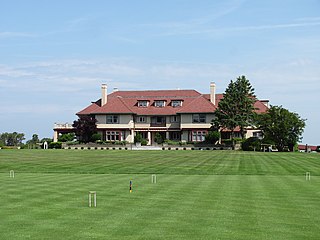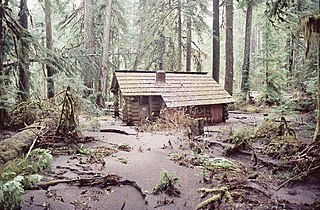
Turkey Run State Park, Indiana's second state park, is in Parke County in the west-central part of the state along State Road 47, 2 miles (3.2 km) east of U.S. 41. The first parcel of land was purchased for $40,200 in 1916, when Indiana's state park system was established during the state's centennial anniversary of its statehood. The origin of the name "Turkey Run" is unknown, but the most accepted theory is that wild turkeys would congregate for warmth in the gorges, where early settlers could easily trap and hunt them. The Lusk Home and Mill Site and the Richard Lieber Log Cabin within the park's grounds were included as individual sites on the National Register of Historic Places in 1974 and 2001, respectively. The park itself was listed on the National Register of Historic Places in 2019. Turkey Run also includes a system of trails, Rocky Hollow Falls Canyon Nature Preserve, a suspension bridge across Sugar Creek, camping sites and other recreational areas. The Turkey Run Inn was built in 1919. Several guest cabins near the inn date from the 1930s and 1940s.

Hole in the Rock is a narrow and steep crevice in the western rim of Glen Canyon, in southern Utah in the western United States. Together with another canyon on the eastern side of the Colorado River, it provided a route through what would otherwise be a large area of impassable terrain.

The Nickerson Mansion is a historic house at 2871 Main Street in Brewster, Massachusetts. The large mansion was built in 1907 by Addie Nickerson and her son Samuel on the foundation of a c. 1880s mansion built by Addie and her husband Roland. The building's interior was lavishly appointed with Italian marble and hand-carved woodwork. The Nickersons owned the property until 1945, when it was purchased by the Missionaries of La Salette, who used it as a seminary. It is now one of the centerpieces of the Ocean Edge Resort.

The Upper Granite Canyon Patrol Cabin was built by the Civilian Conservation Corps about 1935. The log structure is located in the extreme southwest backcountry of Grand Teton National Park. The cabin was built according to a standard design for such structures, in the National Park Service Rustic style. The Moran Bay Patrol Cabin is similar.

The Rosencrans Cabin is part of a small historic district comprising five log buildings on three acres in Bridger-Teton National Forest, just east of Grand Teton National Park. The cabin was used by Rudolph "Rosie" Rosencrans, who played a role in the development of Teton National Forest and who later became a U.S. Forest Service administrator in the early 20th century. Rosencrans was buried at this location.

The Grace and Robert Miller Ranch represents an expansion of the previously existing Miller Cabin listing on the National Register of Historic Places. The ranch was the home of Robert E. Miller, first superintendent of Jackson Hole National Monument. The property was transferred to the U.S. Fish and Wildlife Service as part of the National Elk Refuge.

Slaven's Cabin, also called Slaven's Roadhouse and Frank Slaven Roadhouse, is a public-use facility in the Yukon-Charley Rivers National Preserve in Alaska. The cabin is located on the Yukon River, 42 miles (68 km) southeast of Circle, Alaska, and 138 miles (222 km) northeast of Fairbanks, Alaska. It is listed on the National Register of Historic Places.

The Wonderland Trail is an approximately 93 mile (150 km) hiking trail that circumnavigates Mount Rainier in Mount Rainier National Park, Washington, United States. The trail goes over many ridges of Mount Rainier for a cumulative 22,000 feet (6,700 m) of elevation gain. The trail was built in 1915.

The Ipsut Creek Patrol Cabin was built by the United States National Park Service in 1933 in Mount Rainier National Park to house backcountry rangers. The log cabin resembles other cabins at Huckleberry Creek, Lake James and Three Lakes, all built to standard plans from the Park Service Branch of Plans and Designs, supervised by Acting Chief Architect W.G. Carnes. The cabin is approximately 24 feet (7.3 m) by 14 feet (4.3 m), with a lean-to storage shed to the rear.

The Lake George Patrol Cabin was built in 1934 by the National Park Service in Mount Rainier National Park as a backcountry patrol station and hiker's shelter. The single-story wood-frame building measures about 26.5 feet (8.1 m) by 12 feet (3.7 m). Initially intended as a horse barn, it was converted for ranger accommodation, replacing a 1921 structure. The first cabin survived until 1969, when it was destroyed by a falling tree.

The Mowich Lake Patrol Cabin is one of the oldest backcountry ranger stations in Mount Rainier National Park. Built in 1922, it is located in the western portion of the park. It was used by rangers on boundary patrol, and is located on the Wonderland Trail. The log cabin encloses a 15.5-foot (4.7 m) by 17.5-foot (5.3 m) area, with porch projecting 5.75 feet (1.75 m) to the front. The design was influential in the development of patrol cabin designs in the 1930s. The cabin serves as a cache point for hikers on the Wonderland Trail.
This is a list of the National Register of Historic Places listings in Voyageurs National Park.

The McGurk Cabin in Yosemite National Park was the seasonal home of Yosemite cattleman Jack McGurk from 1895 to 1897. Located on the edge of McGurk's Meadow, just to the north of the Glacier Point Road, the cabin was used by a series of owners beginning with Hugh Davanay, from whom McGurk bought the property in 1895. McGurk was evicted by the Army in 1897 after a dispute over title to the land. The log cabin is a one-room structure, about 14 feet (4.3 m) square, with saddle-notched peeled lodgepole pine logs. The only opening is a low door on the south side. The cabin was stabilized in 1958 by Sierra Club volunteers. It is one of the few structures left in the park that remain from the pre-park era.

The Hodgdon Homestead Cabin was built by Jeremiah Hodgdon in 1879 in the Aspen Valley area of what became Yosemite National Park. The two-story log cabin, measuring 22 feet (6.7 m) by 30 feet (9.1 m), was located in an inholding in the park, owned by Hodgdon's descendants. In the 1950s the family proposed to demolish the structure. The National Park Service acquired it and moved it to its Pioneer Yosemite History Center at Wawona, where the restored cabin is part of an exhibit on early settlement and development of the Yosemite area. In addition to housing Hogdon, the cabin housed workers on the Great Sierra Wagon Road in the 1880s, as a patrol cabin for U.S. Army troops who managed the new national park in the 1890s, and as a historic landmark at the old Aspen Valley Resort.

The Timberline Cabin in Rocky Mountain National Park, Colorado, USA was built in 1925 to house workers on the Fall River Road. The National Park Service rustic style cabin was designed by the National Park Service's Landscape Engineering Division under the direction of Thomas Chalmers Vint. The cabin was later used as a patrol cabin and as a caretaker's residence.

The Thunder Lake Patrol Cabin is a small structure in Rocky Mountain National Park, Colorado. Built in 1930, the 12-foot (3.7 m) by 16-foot (4.9 m) cabin may have been built as a simple shelter, but has more recently been used on an occasional basis as a backcountry patrol cabin in the Wild Basin area. The one story one-room log cabin is not used in the winter, but does have a stove with a stone fireplace. The main cabin is gable-roofed, with a small shed-roofed porch, and is a good example of the National Park Service rustic style. The logs are saddle-notched, projecting an increasing distance at their ends from top to bottom.

The Alice Beck Cabin, also known as the John T. Robinson Cabin, is a recreational cabin on the eastern shore of Lake McDonald in Glacier National Park, Montana. The cabin was built about 1910 at the same time a number of other summer camps were built, prior to the establishment of the park. Since the park was designated, it has remained a private inholding.

Fure's Cabin is a historic 15-by-20-foot log cabin that was built in c.1926. It is located on a narrow isthmus, on the portage trail between Naknek Lake and Lake Grosvenor in Katmai National Park and Preserve on the Alaska Peninsula. Also known as Roy Fure's Trapping Cabin, it was listed on the National Register of Historic Places in 1985; the listing included three contributing buildings and one other contributing structure.

The Hoffman Bridge is a covered bridge near Crabtree in Linn County in the U.S. state of Oregon. It was added to the National Register of Historic Places as Crabtree Creek – Hoffman Covered Bridge in 1987.

The Glen Addie Volunteer Hose Company Fire Hall, at Fourth St. and Pine Ave. in Anniston, Alabama, was built in 1885. It was listed on the National Register of Historic Places in 1985.



















